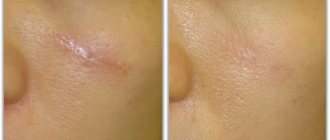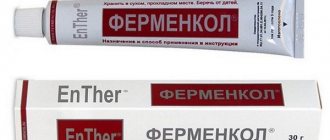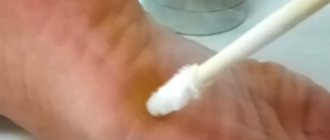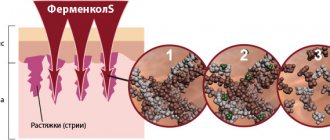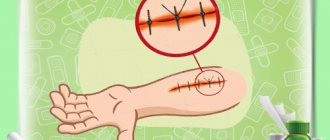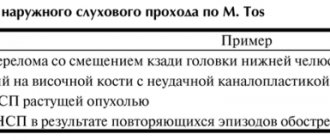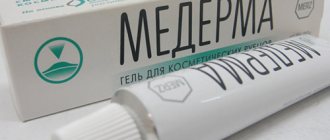Abrasions, scratches, cuts, burns - with the onset of summer, people turn to the pharmacy much more often due to various types of injuries. Even the smallest abrasion can cause a lot of inconvenience, so you always want to speed up the healing process as much as possible. The principles of treatment of mechanical, thermal and chemical damage to the skin differ significantly. Therefore, the selection of drugs for wound healing in a pharmacy is recommended only for mechanical injuries with a small wound surface and depth, not accompanied by severe bleeding. In all other cases, the buyer should be advised to go to a doctor or emergency room. Let's consider the basic principles of selecting healing products from the pharmacy assortment.
Before we begin the analysis, let's remember how the wound process itself proceeds. Regardless of the type of wound and the degree of tissue damage, the wound process goes through three physiological stages of healing.
Stage 2. Proliferation (regeneration)
Under ideal conditions, when a wound heals by primary intention, collagen synthesis by cells begins on the second day. In this case, the edges of the wound are reduced by granulation tissue, which firmly connects the walls of the wound.
When the wound heals by secondary intention, at the regeneration stage, foci of cell division begin to appear in the most cleaned areas - granulation tissue. As the granulations grow, a parallel decrease in the size of the wound begins. The discharge from the wound at the regeneration stage is minimal, serous-hemorrhagic.
Stage 3. Epithelization (final healing)
There is no discharge in the wound, the wound is dry. Discharge can occur if the wound is injured, as well as when an infection occurs. Most often, epithelization begins at the edges of the wound or from the area of the so-called islands of epithelization. In this case, the rest of the wound may be in the proliferation stage.
If at any stage of the wound process an infection occurs, the discharge becomes larger, and it takes on the appearance, color and smell characteristic of a certain type of microorganism.
We should also not forget that the healing time of wounds largely depends on the general condition of the body, age, immunity, chronic diseases and much more. Conditions that can significantly slow down skin regeneration:
- diabetes;
- anemia;
- obesity;
- dermatitis, eczema, psoriasis;
- liver and kidney failure;
- exhaustion of the body (including exhaustion caused by diets);
- hypovitaminosis;
- immunodeficiency;
- smoking;
- oncological diseases.
The speed of wound healing is also affected by:
- Regularity of dressings. Sufficient for timely cleansing of the wound from necrotic tissue and exudate and at the same time not excessive, so as not to damage the resulting delicate foci of granulation, for uncomplicated wounds - 1 time per day
- Regular treatment of the skin around the wound (to prevent infection).
- Sterility of dressing materials.
Factors that can also influence the condition of the scar:
- age of the patient (the older the patient, the slower and worse the healing process occurs);
- hereditary factor (predisposition to the formation of rough, keloid scars);
- endocrine diseases;
- taking certain medications (corticosteroids, anti-inflammatory drugs);
- obesity or underweight.
Remember, compliance with all the instructions of your surgeon will be good soil for the formation of a beautiful scar.
© PlasticRussia, 2022. All rights reserved. Full or partial copying of site materials without the consent of the portal administration is prohibited.
0
Selection
Wound healing agents are selected taking into account the degree of tissue damage and the type of wound.
If the wound is clean and not extensive, then it makes sense to accelerate the regeneration process only at the third stage - the epithelization stage, and the first and second stages require only primary cleansing and regular change of aseptic dressings.
For festering wounds, more extensive and/or deep injuries, consultation with a specialist will be required, since the selection of funds will depend on the severity of the process and may require the prescription of local antibacterial drugs.
So, let’s look at drugs that are popular among buyers and pharmacists to speed up wound healing.
According to the “Register of Medicines of Russia - RLS” for 2017, 1,185 drugs, 143 trade names and 40 active ingredients were registered on the topic “Regenerants and reparants”. The largest number of drugs among tissue-specific stimulators of regeneration also affects the repair of the skin. Indications for the use of these products are difficult-to-heal wounds, trophic ulcers, burns, bedsores and other violations of the integrity of the skin. We included three key tools in the review, according to ten surgeons we interviewed from Moscow, St. Petersburg and Novosibirsk.
Dexpanthenol
Anti-inflammatory, dermatoprotective agent, stimulates regeneration processes. Available in the form of ointments, creams and sprays, in combinations with chlorhexidine digluconate and benzyldimethylmyristoylaminopropylammonium.
Dexpanthenol is quickly absorbed and converted into pantothenic acid, binds to plasma proteins and stimulates skin regeneration. Pantothenic acid is an essential component and stimulator of the synthesis of coenzyme A. Coenzyme A, in turn, is involved in almost all metabolic processes: the tricarboxylic acid cycle, as well as in the metabolism of carbohydrates, fats and fatty acids, phospholipids and proteins.
Dexpanthenol is widely used to treat dry skin, burns (including sunburn), scratches, abrasions, boils, bedsores, cracks and inflammation of the nipples of the breast in nursing mothers. The drug is also used for the prevention and treatment of diaper rash in children.
As a rule, it is well tolerated and can be used during pregnancy and lactation, as well as in children from an early age. Allergic reactions (urticaria, itching) are possible in case of individual intolerance. Preparations based on dexpanthenol have been studied better than others. This is not surprising, because pantothenic acid was isolated at the beginning of the twentieth century and was actively studied.
Deproteinized hemoderivative of calf blood
A drug that improves trophism and tissue regeneration. Available in the form of cream, gel, ointment. There is also a release form in the form of injection solutions and tablets (used as antihypoxants and antioxidants to correct metabolic disorders in chronic diseases of the cardiovascular and nervous systems).
Accelerates repair and regenerative processes in damaged tissues. Increases the absorption and utilization of oxygen, accelerates the transport and utilization of glucose. All this leads to an improvement in the energy metabolism of cells and a decrease in the formation of lactate under ischemic conditions (excessive amounts of lactate in tissues lead to changes in pH, which interferes with adequate regeneration). Strengthens collagen synthesis, stimulates cell proliferation.
Deproteinized hemoderivative of calves' blood is used externally in the form of an ointment and gel for wounds and inflammatory diseases of the skin and mucous membranes, burns (including sunburn), skin cuts, abrasions, scratches, ulcers, as well as for the prevention and treatment of bedsores. Use in children, pregnant and lactating women is possible.
External use is well tolerated. In rare cases, patients with a history of hypersensitivity reactions may develop allergic reactions.
Zinc hyaluronate
Wound healing, regenerating, antimicrobial agent. Available in the form of a gel and solution for external use.
When hyaluronic acid interacts with water molecules, a dispersion matrix appears, which forms a natural supporting frame for cells involved in wound healing, increases the activity of granulocytes and macrophages, enhances the proliferation of fibroblasts and angiogenesis, and accelerates the formation of collagen. The spectrum of antimicrobial activity of zinc includes strains of Staphylococcus aureus, streptococcus, Escherichia coli and Pseudomonas aeruginosa.
When applied topically, systemic resorption is extremely low. Affects all 3 phases of the wound process. Reduces pain during dressings (prevents the dressing from drying out). The solution is used for all types of poorly healing infected wounds, trophic ulcers, bedsores, fistulas; The gel is often used in the complex treatment of acne. There is no data on the use of the drug during pregnancy or lactation. Contraindicated in case of individual intolerance to the components.
Table 1. Use of wound-healing drugs for the treatment of non-infected wounds
| Drug compound | Stages of the wound process | Release form | Ease of use | Peculiarities |
| Hemoderivative of the blood of dairy calves | 1, 2, 3 | Gel, ointment, cream | + | Versatility |
| Zinc hyaluronate | 1, 2, 3 | Solution | — | Versatility |
| Gel | + | |||
| Dexpanthenol | 1, 3 | Ointment, cream, aerosol | + | Application is limited to the stage of the wound process |
| Dexpanthenol + benzyldimethyl-myristoylamino-propylammonium | 2 | Gel | + | Application is limited to the stage of the wound process |
| Dexpanthenol + chlorhexidine bigluconate | 2 | Cream | + | Use limited to wound stage |
Mechanism of scar formation
Wound healing is a complex biological process that lasts about a year and ends with the formation of a mature scar. After a year, the scar tissue continues to change, but very slowly and unnoticeably.
From a physiological point of view, several stages of scar formation can be distinguished: tissue damage -> damaged cells release biologically active substances -> biologically active substances trigger an inflammatory reaction and attract cells that produce collagen (fibroblasts) to the site of injury -> the synthesis of new collagen begins -> a “young” scar is formed (red, swollen, raised above the skin) -> 3 weeks after the injury, excess collagen is absorbed, a normal scar is formed (pale, flat). If you examine normal scar tissue under a microscope, you will see how orderly the collagen fibers are arranged - they are compactly laid out and extended parallel to the surface of the skin.
In some cases, the normal scarring process is disrupted. There are many reasons for this: burns, wound suppuration, lack of adequate comparison of gaping edges, strong tension of the skin surrounding the wound, characteristics of the body’s immune system, hereditary predisposition, etc.
The disorder usually occurs at the stage of collagen synthesis and resorption of its excess. Instead of the usual flat scar, a sunken or protruding scar forms above the skin, and in more rare cases, a keloid scar.
From a practical point of view, it is important to monitor the anatomical, visible changes in healing tissue. For the doctor and the patient, two characteristics of the scar become relevant - strength and appearance. The developed clinical and morphological classification of healing stages allows for timely monitoring of healing stages and selection of appropriate types of scar correction.
Correct form
The selection of the form of the healing agent is no less important than the choice of the active substance. Let's repeat the basic rules.
- Fat-based ointments are contraindicated in the first stage of the wound process - they create a film and prevent adequate outflow of exudate and cleansing of the wound.
- The drug used in the early stages must have a hydrophilic base and retain moisture for a long time. Dosage forms that meet such requirements include solutions, gels, aerosols and creams on a hydrophilic basis.
- Aerosols are convenient for treating burns when any touch to the wound is extremely painful.
- As granulations grow during the second phase of the wound process, more and more of the wound surface must be treated with ointment. And when the wound becomes dry and significantly reduced in size, it is necessary to completely switch to ointment forms. By creating a fatty film on the surface of epithelialization areas, the ointment will protect young sensitive skin cells from drying out and provide them with greater resistance to environmental factors.
Types of scars
- Normotrophic - arise as a result of the normal reaction of connective tissue to injury. These are flat, light-colored scars with normal or reduced sensitivity and elasticity close to normal tissues. Such scars are optimal.
- Atrophic scars - occur as a result of a reduced response of connective tissue to injury. Not enough collagen is formed. Atrophic scars are located below the level of the surrounding skin (sink). With a small width, they practically do not differ from normotrophic ones.
- Hypertrophic scars are the result of an excessive reaction of connective tissue to injury against the background of unfavorable healing conditions (inflammation, stretching of the scar). Fibroblasts with increased activity synthesize an excess amount of collagen, its excess is not completely absorbed. Externally, a hypertrophic scar is a slightly compacted cord protruding above the surface of the skin (in the form of a rope), the width of which can vary. The size of the scar corresponds to the previous skin injury. Hypertrophic scars can smooth out 1-1.5 years after injury, but not always completely.
- Keloid scars develop as a result of a perverted tissue reaction to injury. As a rule, keloids form against the background of reduced levels of general and tissue immunity. Keloids have an elastic consistency, an uneven, slightly wrinkled surface, and protrude significantly above the surface of the skin. Sometimes they look like warts. Keloid scars are constantly growing, sometimes quickly, sometimes slowly, and their growth can be accompanied by itching, burning and pain. As a result of continuous growth, the volume of the visible part of the scar can be several times greater than the volume of its intradermal part. Keloids are not capable of spontaneous regression. A typical example is keloid scars that form after earlobe piercing to wear jewelry.
Source: Medical
Home first aid kit
However, if we are talking about a universal remedy, which is better to have in a home medicine cabinet and which is suitable for all family members, then preference should be given to dexpanthenol preparations, which are approved for use in children from the first days of life, in pregnant women and women during lactation. Since at each stage of the wound process different forms of release of this drug are recommended, it would be optimal to have an ointment and a cream or gel combined with an antiseptic in the first aid kit.
Sources
- Abaev Yu. K. Biology of acute and chronic wound healing // Medical news. - 2003. - T. 6. - P. 3–10.
- Afanasyev V.V. // Solcoseryl: results and prospects. Collection of scientific and practical works. articles. St. Petersburg - 1997. - pp. 4–9.
- Butko Ya. A., Drogovoz S. M., Deeva T. V., Lyapunov N. A. Study of the reparative properties of creams with dexpanthenol and ceramides // Scientific bulletins of BelSU. Series: Medicine. Pharmacy. - 2013. - No. 18 (161).
- Zhilyakova E. T., Ivashchenkova A. O. Analysis of the Russian pharmaceutical market of drugs for the treatment of thermal burns // Young scientist. - 2022. - No. 39 (8).


